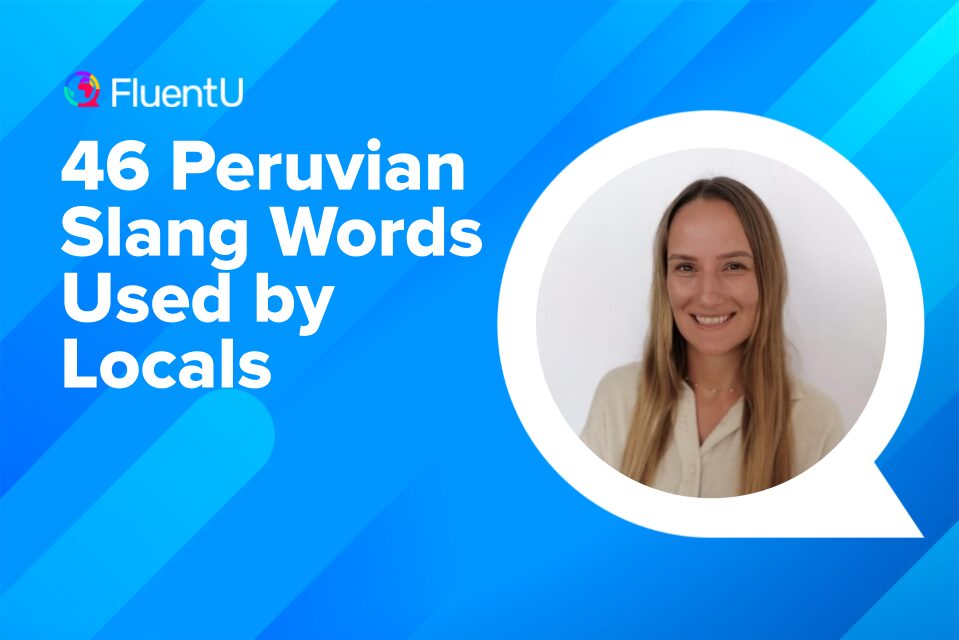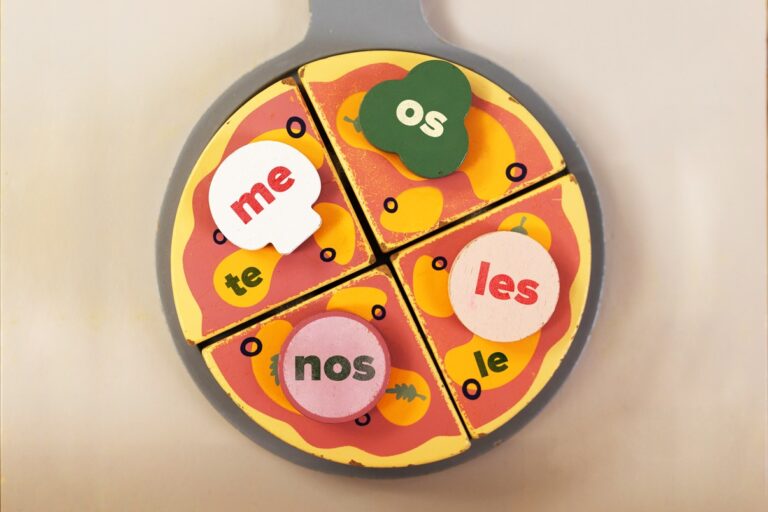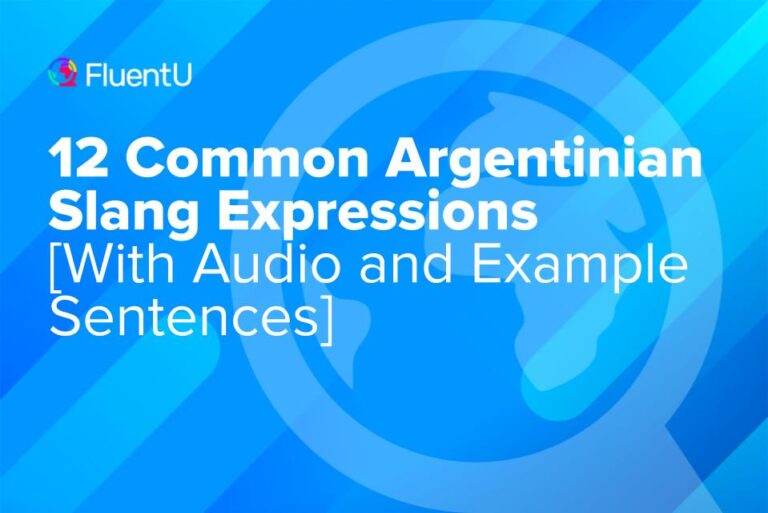Contents
- 1. Pata
- 2. Luca
- 3. Pe
- 4. Jamear / jama
- 5. Chamba
- 6. Pitri mitri
- 7. Tono
- 8. Pisco
- 9. Pisco sour
- 10. Roche
- 11. Bacán
- 12. Chévere
- 13. Tirarse la pera
- 14. Yapa
- 15. Cholo
- 16. Mote
- 17. Porfa
- 18. Tombo
- 19. Coca cola
- 20. A su madre
- 21. Al toque
- 22. Bróder
- 23. Asado
- 24. Calabaza
- 25. Bamba
- 26. Figureti
- 27. Hacer chancha
- 28. Chibolo
- 29. Choche
- 30. Pituco
- 31. Pura finta
- 32. Chato
- 33. Latear
- 34. Huasca
- 35. Estar tranca
- 36. Por las puras
- 37. Soroche
- 38. Fercho
- 39. Chela
- 40. Florear
- 41. Cojudo / Cojuda
- 42. Costilla
- 43. Flaco / Flaca
- 44. Huevear
- 45. Huevón
- 46. Piña
- Quiz on Peruvian Slang
- How to Practice Peruvian Slang
- And One More Thing…
46 Peruvian Slang Words Used by Locals

Knowing Peruvian slang will help you communicate better and understand more about the rich culture in Peru. It’s the gap between speaking Spanish and speaking Spanish like the locals.
Below you’ll learn 46 of the most important Peruvian slang terms you should know to sound like a native, then you can take a short quiz to test what you’ve learned!
Download: This blog post is available as a convenient and portable PDF that you can take anywhere. Click here to get a copy. (Download)
1. Pata
Pata in standard Spanish means the leg or paw of an animal. However, this is the Peruvian slang replacement for amigo (friend). Note that it always ends with an a, whether you’re referring to a male or a female.
Es mi pata. (He’s my pal.)
2. Luca
The currency in Peru is the sol, and the slang word is luca. According to one source, it comes from the Spanish gypsies’ word for money.
No puedo ir de compras; no tengo luca. (I can’t go shopping, I don’t have money.)
Check out this post for more slang words to describe money in Spanish.
3. Pe
Spanish speakers from some lands litter their sentences with pues (then, well) as a meaningless filler word. Peruvians use the shortened form pe.
Pe, no sé. (Well, I don’t know.)
4. Jamear / jama
The slang verb jamear is common in a few Latin American countries as an alternative to comer (to eat). Jama is the noun form, so it just means “food.”
Tengo hambre; necesito jama. (I’m hungry, I need food.)
5. Chamba
You don’t have a trabajo (job) in informal Peruvian jargon, you have a chamba.
Sí, me gusta mi chamba. (Yes, I like my job.)
6. Pitri mitri
This is a cutesy, rhyming way to say “Awesome!”
¡Esta canción es pitri mitri! (This song is awesome!)
7. Tono
Use this word instead of fiesta (party).
Hay un tono el viernes. (There’s a party on Friday.)
8. Pisco
This isn’t so much slang as it is an important national beverage that you must be aware of if you’re going to Peru— brandy made from grapes.
If you have a high-end pisco, enjoy it straight; otherwise, you’ll want to use it to make the next term…
Nunca he probado el pisco. (I’ve never tried pisco.)
9. Pisco sour
This is the national cocktail of Peru, and you can instantly spark a fight by suggesting to Peruvians that it might be Chilean.
Regardless, both countries do a fabulous job with it, and it’s famous enough internationally that you can find good pisco anywhere.
Tomaré un pisco sour, por favor. (I’ll take a pisco sour, please.)
10. Roche
This is a slang version for vergüenza (shame/embarrassment).
Me da roche hablar de eso. (I’m embarrassed to talk about that.)
11. Bacán
This could be translated as “awesome,” “great,” “cool,” etc. It’s also used in other South American countries like Ecuador.
You’ll often hear “¡Qué bacán!” (“How cool!”) in everyday, casual conversations.
Ese carro es bacán. (That car is cool.)
12. Chévere
This is another way to say “cool” in Spanish slang, often used in Latin American countries like Peru and Ecuador.
¡Que chévere! (How cool!)
13. Tirarse la pera
This means to play hooky (truant for you Brits). Literally, tirar is “to throw,” tirarse is a colloquial (but not vulgar) word for sleeping with someone and la pera is “the pear.”
Mi hermano se tira la pera a menudo. (My brother skips school often.)
14. Yapa
This means “more” or “extra.”
¿Puedes darme yapa? (Can you give me a bit more?)
15. Cholo
In Peru, this can be an extremely disrespectful way of referring to natives from the Andes, so you’ll probably want to pass on using this word.
Regardless, it’s good to know what it means because you might hear it used neutrally or positively in the right contexts. For example:
Cholo, ¿qué pasa? (Hey dude, what’s up?)
16. Mote
This word can denote both an accent and a speech defect. You’ll likely have a mote extranjero, or foreign accent.
Your Peruvian friends might have a mote provinciano (provincial accent), mote norteño (northern accent), mote serrano (highland accent) or mote charapa (jungle accent).
The word comes from Quechua, and be careful as it’s often a disrespectful way of saying that someone isn’t speaking right. Probably another word that you should avoid using, but is good to know in case you hear it flying around.
Me dijo que tengo mote. (He told me that I have an accent.)
17. Porfa
This is a shortening of por favor (please). You may also hear porfis. This slang word isn’t unique to Peru, but you may hear it there in casual conversation between friends.
¿Puede ayudarme porfa? (Can you help me please?)
18. Tombo
In proper Spanish, this would be la policía (the police) but in the Andes, they’re informally known as el tombo.
No queremos econtrarnos con el tombo. (We don’t want to run into the police.)
19. Coca cola
You’ve heard of the drink, but probably not its fun usage as a way to describe someone. Estar coca cola in Peru means to be going crazy or out of your mind, while un coca cola is used to refer to a crazy person.
Debes estar coca cola si quieres que te voy a comprar un carro. (You must be crazy if you think I’m going to buy you a car.)
20. A su madre
This is an expression of surprise that you may hear shortened to “asu!” Say your friend jumps out and scares you. You might exclaim:
¡A su madre! ¡Me asustaste! (Ah! You scared me!)
21. Al toque
This means “right away,” to express a sense of urgency.
Necesito un médico al toque. (I need a doctor right away.)
22. Bróder
This is a term of endearment that’s derived from the English word “brother.”
¿Qué pasa bróder? (What’s up, brother?)
23. Asado
This literally means “roast” but is used to say that someone is angry.
Mi padre está asado porque llegué tarde a casa. (My dad is angry because I came home late.)
24. Calabaza
While this word translates directly to “pumpkin,” it’s also a way to call someone dumb or empty-headed.
Sara es una calabaza; se olvidó de su tarea. (Sara is dumb, she forgot about her homework.)
25. Bamba
This slang term refers to something false or fake. You’ll hear it most often in markets where they frequently sell cheap knock-offs of luxury items.
Ese bolsa no es de diseñador, es bamba. (That purse isn’t designer, it’s fake.)
26. Figureti
You can use this word to talk about someone who’s a show-off.
Ella sólo es agradable cuando la cámara está cerca, es una figureti. (She’s only nice when the camera is around, she’s a show-off.)
27. Hacer chancha
When you need to split the bill amongst friends, you’ll refer to it as hacer chancha.
Si no quieres hacer chancha, puedo pagar. (If you don’t want to split the bill, I can pay.)
28. Chibolo
This word is used to refer to kids or young people. You may also hear it used for someone who’s acting like child.
No me gustan los chibolos. (I don’t like kids.)
29. Choche
Spanish has many words for “friend,” and this is another one that’s used in Peru.
Voy a ir al cine con mi choche. (I’m going to go to the movies with my friend.)
30. Pituco
Use this one to talk about someone who looks or acts like they’re rich.
Todos los pitucos viven en ese barrio. (All the rich people live in that neighborhood.)
31. Pura finta
While bamba is used to call things fake, pura finta is used to call a person fake.
Elena habla mal de sus amigas, es pura finta. (Elena talks bad about her friends, she’s fake.)
32. Chato
This word is used to refer to a short person, most often as a nickname.
Este es Jose, pero lo llamamos chato. (This is Jose, but we call him shortie.)
33. Latear
This is slang for “to walk.”
Están lateando a tu casa. (They’re walking to your house.)
34. Huasca
This is what you use if you need to say you’ve had a little bit too much to drink and are feeling the effects. In other words, you’re wasted.
Estoy huasca, necesito beber agua. (I’m drunk, I need to drink water.)
35. Estar tranca
If you need to say something is difficult, use this slang term.
Está tranca abrir esta puerta. (It’s difficult to open this door.)
36. Por las puras
Use this term if you feel like you did something that was a complete waste of time.
Hemos caminado todo este camino por las puras. (We’ve walked all this way for nothing.)
37. Soroche
A pretty common experience for travelers that come to Peru, you may need this word to tell your doctor or trek guide that you have altitude sickness.
Es común sufrir de soroche en Machu Picchu. (It’s common to suffer from altitude sickness at Machu Picchu.)
38. Fercho
This is a slang term for a driver or chauffeur.
Mi padre contrató un fercho. (My dad hired a driver.)
39. Chela
If you want to grab some beers with friends, this is the word you’ll use.
Tomaré una chela porfa. (I’ll take a beer please.)
40. Florear
Florear is a common word for lying, but not just any lie. This is more like when someone is lying to you, but really trying to make things sound good. Almost like flattery or sugar-coating.
Estás tratando de florearme sobre tu noche, pero no te creo. (You’re trying to lie to me about your night, but I don’t believe you.)
41. Cojudo / Cojuda
Along with words for “friend,” Spanish is also in no short supply of words for “idiot.”
Robó en el supermercado y le pillaron, qué cojudo. (He stole from the supermarket and got caught, what an idiot.)
42. Costilla
This is a fun little way to call someone your girlfriend. It literally means “rib,” a reference to Eve coming from Adam’s rib.
Mi costilla se va de vacaciones conmigo y mi familia. (My girlfriend is going on vacation with me and my family.)
43. Flaco / Flaca
This word literally means “skinny” or “thin.” But keeping in theme with names for significant others, it can be used for a boyfriend or girlfriend. Just remember to change the ending to reflect the gender.
¿Donde conociste a tu flaco? (Where did you meet your boyfriend?)
44. Huevear
You can use huevear to describe when you’re doing absolutely nothing.
Estamos hueveando, deberíamos salir. (We’re doing nothing, we should go out.)
45. Huevón
This is similar to the last word, but it means something totally different. Huevón refers to a dumb person.
Amo a mi amigo, pero es huevón. (I love my friend, but he’s dumb.)
46. Piña
I’m sure you’re thinking of the delicious yellow fruit, but this slang term doesn’t always mean “pineapple” in Peru. In this country, a piña is someone with bad luck.
Es un piña, siempre pierde las llaves. (He has bad luck, he always loses his keys.)
Quiz on Peruvian Slang
Now that we’ve gone over some Peruvian slang terms, it’s time to test what you’ve learned! Take the short quiz below (without looking at the answers above!) and just refresh the page if you want to start over or retake it.
How to Practice Peruvian Slang
The best way to solidify new vocabulary is to practice using it in conversation. So find your Peruvian friends and start chatting! Listen to how they throw slang into their speech and then try it yourself.
If you don’t have immediate access to a Peruvian conversation partner, you can also try and immerse yourself at home. Try watching videos on YouTube made by Peruvian creators. Informal videos like vlogs will surely have lots of slang.
Or you can find YouTube videos specifically meant to teach you Peruvian slang, like this one from the Spanish With Nate channel:
You can also use FluentU to watch even more clips that Peruvians would watch to see how they speak Spanish and use slang.
FluentU takes authentic videos—like music videos, movie trailers, news and inspiring talks—and turns them into personalized language learning lessons.
You can try FluentU for free for 2 weeks. Check out the website or download the iOS app or Android app.
P.S. Click here to take advantage of our current sale! (Expires at the end of this month)

Now you have 46 Peruvian slang terms in your word bank that you can whip out in conversation—or at least use to understand Peruvians better!
Download: This blog post is available as a convenient and portable PDF that you can take anywhere. Click here to get a copy. (Download)
And One More Thing…
If you've made it this far that means you probably enjoy learning Spanish with engaging material and will then love FluentU.
Other sites use scripted content. FluentU uses a natural approach that helps you ease into the Spanish language and culture over time. You’ll learn Spanish as it’s actually spoken by real people.
FluentU has a wide variety of videos, as you can see here:

FluentU brings native videos within reach with interactive transcripts. You can tap on any word to look it up instantly. Every definition has examples that have been written to help you understand how the word is used. If you see an interesting word you don’t know, you can add it to a vocab list.

Review a complete interactive transcript under the Dialogue tab, and find words and phrases listed under Vocab.

Learn all the vocabulary in any video with FluentU’s robust learning engine. Swipe left or right to see more examples of the word you’re on.

The best part is that FluentU keeps track of the vocabulary that you’re learning, and gives you extra practice with difficult words. It'll even remind you when it’s time to review what you’ve learned. Every learner has a truly personalized experience, even if they’re learning with the same video.
Start using the FluentU website on your computer or tablet or, better yet, download the FluentU app from the iTunes or Google Play store. Click here to take advantage of our current sale! (Expires at the end of this month.)







